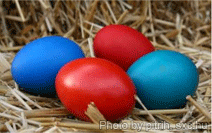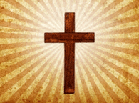There are many symbols associated with the holiday of Easter. While many of these symbols, like the Easter Bunny and Easter eggs, are well known and recognized, their meanings aren't always as familiar. The examples below highlight the meaning of some of the most famous Easter symbols.
Easter Eggs

Photo by pitrih, sxc.hu
Ancient cultures have long regarded eggs as symbols of fertility and rebirth. As birds lay their eggs in the spring, the appearance of eggs was seen as the end of winter. As Christianity spread throughout the world, many of these pagan beliefs were incorporated into the Christian holiday. Eggs have also come to symbolize Jesus' tomb. Just like the chick breaks out of the egg, Jesus was resurrected and broke out of his tomb. Today, a popular Easter tradition is to decorate eggs. Whether eaten or just put on display, these colorful eggs are perhaps the most famous of all Easter symbols.
Easter BunnyLike the Easter egg, the Easter Bunny has its roots in pre-Christian paganism. The hare was associated with an ancient goddess of fertility, worshiped by people in what is now Germany. Aside from that, hares and rabbits had long been a sign of the end of winter and the beginning of spring. As Christianity spread, some of these older traditions were incorporated into the religion. The hare eventually transformed into the Easter Bunny, who is said to leave gifts of eggs, candy, and toys for children on Easter.
LambsLambs are symbolic of Easter for several reasons. Just like eggs and rabbits, newborn lambs represent the coming of spring. There are a couple of religious reasons too. In the Bible, Jesus is referred to as the "Lamb of God," and Jesus is also described as a shepherd leading a flock. On another note, lamb is often included as part of the holiday meal for many families.
Flowers

Photo by Buckey, sxc.hu
Flowers are yet another symbol of Easter that relates to the arrival of spring. Flowers blooming at the beginning of the season, like daffodils, tulips, and hyacinth, are an integral part of any Easter decoration. White lilies have also become a standard Easter flower, as their pure white coloring represents the purity of Jesus. Another Easter flower is the lily of the valley, whose simple white flowers are said to represent the Virgin Mary's tears after Jesus was crucified.
Bonfires and CandlesBright light has long been a symbol of both power and faith. Candles are lit on Easter as a way of symbolizing the light of Jesus. In many cultures, bonfires also play a role in Easter celebrations. Pre-Christian civilizations used to create bonfires as a way of scaring away the evil spirits of winter and ushering in the spring season. Today, people in certain parts of the world use their old Christmas trees to create the bonfires.
ButterfliesThese insects have become a symbol of Easter, as the lifecycle of a butterfly is similar to the experiences of Jesus. The caterpillar stage of the butterfly represents his life on earth. When the caterpillar seals itself off in a cocoon, it can correlate to Jesus' death and burial in a tomb. In the final stage in the life of a butterfly, it emerges from the cocoon and flies away, symbolizing Jesus' resurrection.

Image by ba1969, sxc.hu
The symbol of Christianity, the cross plays an important role in the Easter holiday. Jesus was tortured and died on a cross, which at that point in time became a symbol of pain and suffering. After Jesus' resurrection, the cross became a symbol of victory over death. Today it is perhaps the most recognized symbol of faith.